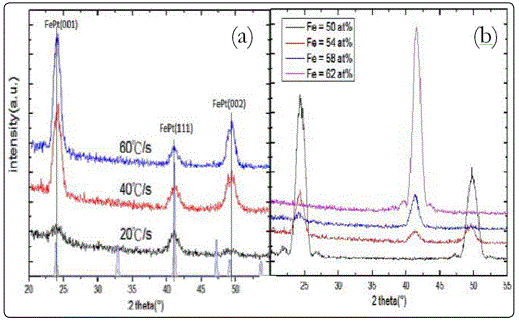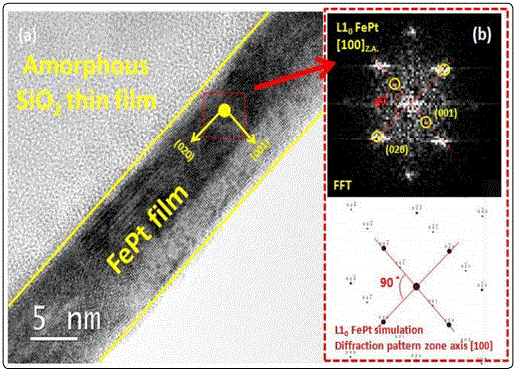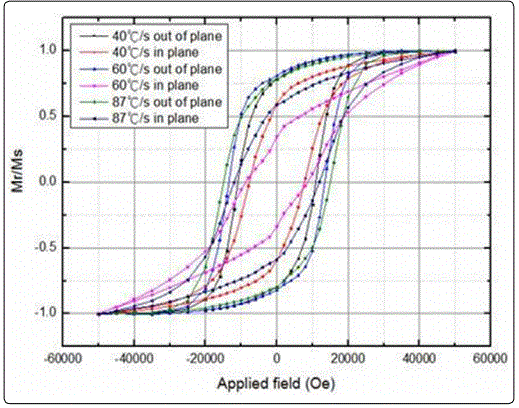Research Article
(001)-Oriented Nonexpitaxial L10 FePt by Rapid Thermal Annealing
Department of Materials Science and Engineering, National Tsing Hua University, Taiwan
*Corresponding author: Chuenhou(Hao) Ouyang, Professor, Department of Materials Science and Engineering, National Tsing Hua University, Taiwan, Tel: +886-3-5715131#42172, Fax: +886-3-5722366, E-mail: houyang@mx.nthu.edu.tw
Received: February 19, 2016 Accepted: April 5, 2016 Published: April 11, 2016
Citation: Chiou JY, Ouyang C. (001)-Oriented Nonexpitaxial L10 FePt by Rapid Thermal Annealing. Madridge J Nanotechnol Nanosci. 2016; 1(1): 4-6. doi: 10.18689/mjnn-1000102
Copyright: © 2016 The Author(s). This work is licensed under a Creative Commons Attribution 4.0 International License, which permits unrestricted use, distribution, and reproduction in any medium, provided the original work is properly cited.
Abstract
Highly L10-ordered FePt thin films with a strong (001) texture were successfully fabricated on SiO2/Si substrates by sputtering and rapid thermal annealing. Large biaxial tensile-stress was induced by controlling the heating rate, causing a transition of orientation from (111) to (001) texture of L10 FePt. We observed that not only heating rate, but FePt composition and the annealing time are strongly dependent on (001) texture. These factors also affect the magnetic properties of FePt.
Keywords: Rapid thermal annealing; Magnetic properties; Gas pressure; Magnet.
Introduction
In the past years, L10 FePt have been widely studied due to its promising applications such as high density recording media and permanent magnet [1]. L10-FePt has been proposed to be a promising candidate as ultrahigh-density perpendicular magnetic recording media due to its large magnetocrystalline anisotropy (Ku~7×107 erg/cc) [2] and excellent resistance to corrosion [3]. To efficiently promote the L10 ordering in the FePt thin film, deposition or post-annealing at high temperature is generally indispensable. This high temperature process is unfavorable in view of the compatibility for a practical device fabrication process. Many studies focusing on lowering the ordering temperature of L10 FePt were reported, for example, stress-induced phase transformation by depositing on a specific under layers (such as MgO [4], CrRu [5], Cr [6], TiN [7]) or by adding third elements (such as Cu [8], Ag [9], SiO2 [10], B2O3 [11]). Then rapid thermal annealing (RTA) is also considered as a useful technique to enhance the nonexpitaxial FePt ordering. It was reported that different value of in plane tensile stress can be induced by controlling the heating rate of rapid thermal annealing (RTA) [12-14]. There are some important parameter would influence FePt ordering in the RTA process. In this letter, a multilayered structure was used to deposit FePt in order to well control of FePt composition and improve the film property. Dependence of preferred orientation on heating rate and annealing time of FePt film was also explored in details.
Experiment
Thin FePt films were prepared by alternating growth of Fe and Pt layers composed of [Fe(x Å )/Pt(4 Å )]8 on substrates of SiO2 (90nm)//Si through an ultra-high vacuum dual ion beam deposition system (DIBD) at an ambient temperature with a background pressure lower than 5×10-8 torr. A composition series of FePt were obtained by depositing different thickness of Fe layers. Ar gas pressure during sputtering was 4×10-4 torr. Samples were subsequently annealed in vaccum (<1×10-5 torr) at 550 °C with different heating rates (20, 40, 60, and 87 °C/s). Chemical compositions of all samples were determined by energy dispersive X-ray spectroscopy (EDS). A spherical aberration corrected (scanning) transmission electron microscopy of JEOL JEM-ARM 200F operating at 200 kV equipped with energy-dispersive X-ray spectroscopy (EDS) was used for elemental and microstructural analyses. Structures were identified also by using X-ray diffraction (XRD) with Cu Kα radiation. Magnetic hysteresis loops of FePt film were measured by a superconducting quantum interference device (SQUID, Quantum Design MPMS-XL) with a maximum field of 50 kOe at room temperature.
Result and Discussion
Figure 1A showed the θ-2θ scans of XRD for FePt films on SiO2 (90nm)/Si annealed at 550 °C with different heating rate and the related simulation of random directions by CaRIne Crystallography. FePt thin films deposited on amorphous substrates generally show the (111) preferred orientation since the (111) plane have lowest surface energy [15]. The (001) superlattice and (002) fundamental diffraction peaks of L10-FePt were observed for all samples, demonstrating good [001]-preferred orientation of L10-FePt [12]. Then we can find that all the peaks are shifted to higher angle compared with the XRD simulation, which means FePt films subjected to tensile stress. The full-width at half-maximum (FWHM) values determined from (001) reflection for all sample were lower than 1.8°, demonstrating that all samples with good crystal quality. Figure 1B showed the different compositions of FePt with heating rate of 40 °C/s. The different composition of FePt was deposited by changing the Fe layer thicknesses, which was determined by EDS. Only around stoichiometric composition of FePt has good (001)-orientation. In the Fe-50 at % films, we successfully fabricated highly L10-ordered FePt samples with a strong

(001) texture and the HRTEM image was showed in Figure 2. By comparing the local diffraction pattern obtained from FFT in FePt film with L10 ordered FePt simulated diffraction patterns, strong superlattice diffraction spots (001) with the magnetization easy axis [001] direction perpendicular to film plane were observed. This was consistent with perpendicular magnetic anisotropy property measured by XRD.

Figure 3 showed magnetization curves of the samples annealed with different RTA heating rates. With increasing heating rate, both the in plane and out of plane coercivities increased. This can be due to the reason that larger in-plane tensile-stress was induced by larger heating rate. Therefore, more defects were produced to be pinning sites, which can pin the domain walls and, therefore, the coecivity was increased [16].

Conclusion
In summary, with different heating rate of RTA, different values of in-plane tensile-stress were induced to enhance FePt ordering, which result in pinning sites. More pinning sites will pin the domain walls and then increase the coecivities of FePt thin films. Ordering of FePt thin film is also strongly dependent on chemical composition. Only around stoichiometric composition of FePt has the good (001)-orientation. Finally, we produced nearly perfect (001) oriented FePt films by nonexpitaxial deposition.
Conflicts of Interest: The author(s) report(s) no conflicts of interest.
References
- Chinnasamy CN, Huang JY, Lewis LH, Latha B, Vittoria C, Harris VG. Direct chemical synthesis of high coercivity air-stable SmCo nanoblades. Appl Phys Lett. 2008; 93: 032505.1-032505.3. doi: 10.1063/1.2963034
- Weller D, Moser A, Folks L, et al. High K u materials approach to 100 Gbits/in 2. IEEE Trans Magn. 2000; 36: 10-15. doi: 10.1109/20.824418
- Shima T, Moriguchi T, Mitani S, Takanashi K. Low-temperature fabrication of L10 ordered FePt alloy by alternate monatomic layer deposition. Applied physics letters. 2002; 80(2): 288-290. doi: 10.1063/1.1432446
- Chen JS, Lima BC, Ding YF, Chow GM. Low-temperature deposition of L10 FePt films for ultra-high density magnetic recording. Journal of magnetism and magnetic materials. 2006; 303(2): 309-317. doi: 10.1016/j.jmmm.2006.01.106
- Feng YC, Laughlin DE, Lambeth DN. Formation of crystallographic texture in rf sputter-deposited Cr thin films. Journal of applied physics. 1994; 76(11): 7311-7316. doi: 10.1063/1.358019
- Dong KF, Li HH, Peng YG, Ju G, Chow GM, Chen JS. L10 FePt-ZrO2 (001) nanostructured films with high aspect ratio columnar grains. Applied Physics Letters. 2014; 104(19): 192404. doi: 10.1063/1.4878263
- Takahashi YK, Ohnuma M, Hono K. Effect of Cu on the structure and magnetic properties of FePt sputtered film. Journal of magnetism and magnetic materials. 2002; 246(1): 259-265. doi: 10.1016/S0304-8853(02)00065-3
- Platt CL, Wierman KW, Svedberg EB, et al. ordering and microstructure of FePt thin films with Cu, Ag, and Au additive. Journal of Applied Physics. 2002; 92(10): 6104-6109. doi: 10.1063/1.1516870
- Luo CP, Sellmyer DJ. Structural and magnetic properties of FePt: SiO2 granular thin films. Appl Phys Lett. 1999; 75: 3162. doi: 10.1063/1.125264
- Ichitsubo T, Tojo S, Uchihara T, et al. Mechanism of c-axis orientation of L10 FePt in nanostructured Fe Pt/ B2O3 thin films. Physical Review B. 2008; 77(9): 094114. doi: 10.1103/PhysRevB.77.094114
- Wang LW, Shih WC, Wu YC, Lai CH. Promotion of [001]-oriented L10-FePt by rapid thermal annealing with light absorption layer. Applied Physics Letters. 2012; 101(25): 252403. doi: 10.1063/1.4772072
- Hsiao SN, Liu SH, Chen SK, Chin TS, Lee HY. Direct evidence for stressinduced anisotropy of rapid-annealed FePt thin films. Applied Physics Letters. 2012; 100(26): 261909. doi: 10.1063/1.4730963
- Mizuguchi M, Sakurada T, Tashiro TY, Sato K, Konno TJ, Takanashi K. Fabrication of highly L10-ordered FePt thin films by low-temperature rapid thermal annealing. APL Materials. 2013; 1(3): 032117. doi: 10.1063/1.4821629
- Kim JS, Koo YM, Lee BJ, Lee SR. The origin of (001) texture evolution in FePt thin films on amorphous substrates. Journal of applied physics. 2006; 99(5): 053906. doi: 10.1063/1.2176088
- Ristau RA, Barmak K, Lewis LH, Coffey KR, Howard JK. On the relationship of high coercivity and L10 ordered phase in CoPt and FePt thin films. Journal of applied physics.1999; 86(8): 4527-4533. doi: 10.1063/1.371397


